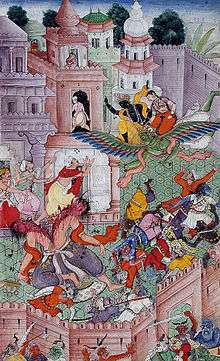Naraka Chaturdashi
Naraka Chaturdashi (also known as Kali Chaudas, Roop Chaudas, Choti Diwali , Naraka Nivaran Chaturdashi or Bhoot Chaturdashi) is a Hindu festival, which falls on Chaturdashi (14th day) of the Krishna Paksha in the Vikram Samvat Hindu calendar month of Kartik. It is the second day of the five-day-long festival of Deepavali/Diwali. The Hindu literature narrates that the asura (demon) Narakasura was killed on this day by Krishna, Satyabhama and Kali.[1] The day is celebrated by early morning religious rituals and festivities follow on.
| Naraka Chaturdashi | |
|---|---|
| Also called | Roop Chaturdashi Kali Chaturdashi |
| Observed by | Hindus |
| Type | Religious, India |
| Observances | Prayers, religious rituals |
| Date | Kartik Krishna Chaturdashi |
| 2019 date | 26 October, Saturday |
| 2020 date | 13 November, Friday |
| 2021 date | 3 November , Wednesday |
| Frequency | annual |
Meaning in Hinduism
The festival is also called as "Kali Chaudas", where Kali means dark (eternal) and Chaudas means fourteenth, this is celebrated on the 14th day of the dark half of Aaso. In some regions of India, Kali Chaudas is the day allotted to the worship of Mahakali or Shakti and is believed that on this day Kali killed the asura (demon) Narakasura. Hence also referred to as Naraka-Chaturdashi, Kali Chaudas is day to abolish laziness and evil which create hell in our life and shine light on life. Narak Chaturdashi, celebrated just one day before Diwali, is also known as small Diwali.[2]
Rituals associated
The puja is performed with oil, flowers, and sandalwood. Coconuts are also offered to Lord Hanuman and Prasada of sesame seed, jaggery and rice flakes (poha) with ghee and sugar.
The rituals of Kali Choudas is strongly suggestive of the origin of Diwali as a harvest festival is performed. On this day delicacies are prepared from pounded semi-cooked rice (called Poha or Pova). This rice is taken from the fresh harvest available at that time. This custom is prevalent both in rural and urban areas especially in Western India.

On this day, a head wash and application of kajal in the eyes is believed to keep away the kali nazar (evil eye). Some say that those who are into tantra, learn their 'mantras' on this day. Alternatively, people offer Nivet is local to where they are originally from. This goddess is called their Kula Devi, in order to cast off evil spirits. Some families also offer food to their forefathers on this day. The second day of Deepavali is known as Kali Choudas in Rajasthan, Gujarat & few part of Maharashtra.
On this day Hindus get up earlier than usual. The men will rub their bodies in perfumed oils before bathing. Afterwards, clean clothes are worn; some people wear new ones. A large breakfast is enjoyed with relatives and friends. In the evening, a mix of bright and loud fireworks are set off in an atmosphere of joyful fun and noise. Special sweet dishes are served as part of the midday meal. House are lit with oil lamps during the evening.
In Goa, paper-made effigies of Narakasura, filled with grass and firecrackers symbolising evil, are made. These effigies are burnt at around four o'clock in the morning and then firecrackers are burst, and people return home to take a scented oil bath. Lamps are lit in a line. The women of the house perform aarti of the men, gifts are exchanged, a bitter berry called kareet is crushed under the feet in token of killing Narakasura, symbolising evil and removal of ignorance. Different varieties of Poha and sweets are made and eaten with family and friends.[3]
In the state of West Bengal the day before the Kali Puja is observed as Bhoot Chaturdashi. The veil between the two worlds is thin and it is believed on the eve of this dark night the souls of the deceased come down to earth to visit their dear ones. It is also believed that the 14 forefathers of a family visit their living relatives and so 14 Diyas are placed all around the house, to guide them homewards and especially to chase away the evil ones. Every dark corner and nook is illuminated with light.
[4]Abhyanga Snan on Narak Chaturdashi day holds a special significance in a person's life. Abhyanga Snan is always done during the presence of moon but before sunrise while Chaturdashi Tithi is prevailing. This snan is done using ubtan of sesame(til) oil. Snan done with this ubtan helps protect the persons from poverty, unforeseen events, misfortune, etc.
In Southern India
In Goa, Karnataka and Tamil Nadu, Deepavali is traditionally celebrated on Naraka Chathurdasi day while the rest of India celebrates it on the no moon night (Amavasya), which is the next day. In some parts of south India this is also called as Deepavali Bhogi. People get up earlier and celebrate with oil baths, pooja, and festivals. Firecrackers are usually lit on Deepavali. Some Tamil homes observe "nombu" and do Lakshmi Puja on this day. In Karnataka the festival of Deepavali starts from this day i.e. Naraka Chathurdashi and extends till Bali Padyami.
References
- Ray, Dipti (2007). Prataparudradeva, the Last Great Suryavamshi King of Orissa (A.D. 1497 to A.D. 1540). Northern Book Centre. p. 89. ISBN 8172111959. Retrieved 22 October 2014.
- "Narak Chaturdashi 2017". Amar Ujala. Retrieved 18 October 2017.
- Sakhardande, Prajal. "Diwali and the Narkasur Battle". The Navahind times. Retrieved 1 November 2013.
- "Narak Chaturdashi: Why Kali Chaudas or Narak Chaturdashi Puja So Important!". Vamtantra. Retrieved 2019-10-06.
